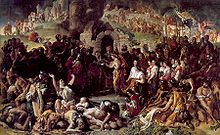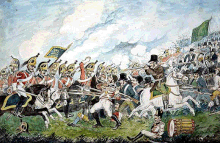Military history of Ireland
This article has multiple issues. Please help or discuss these issues on the talk page. (Learn how and when to remove these template messages)
|
| History of Ireland |
|---|
 |
|
|
The military history of Ireland comprises thousands of years of armed actions in the territory encompassing the island of Ireland.
Early history[]

Ireland was never invaded by the Roman Empire, and the island remained a warring collection of separate kingdoms throughout its early history. Although it is known that the Romans traded with the Irish kingdoms, historically it was thought that the Romans never established a military presence in Ireland. In recent times the find of ruins of a possibly Roman fort in Drumanagh near Dublin has questioned this belief.[1]
In the 5th century, Irish tribes known to the Romans as the Scoti invaded northern Britain, displacing the native Picts and establishing the kingdom of Dál Riata. As this kingdom expanded in size and influence, the name of the tribe was applied to all its subjects – hence the modern terms Scot, Scottish and Scotland. The English annal writer, Bede, wrote how the Scoti harassed the Romano-British in piratical and border raids.
The Vikings pillaged monasteries on Ireland's west coast in 795, and then spread out to cover the rest of the coastline. The north and east of the island were most affected. During the first 40 years, the raids were conducted by small, mobile Viking groups. From 830 on, the groups consisted of large fleets of Viking ships. From 840, the Vikings began establishing permanent bases at the coasts. Dublin was the most significant settlement in the long term. The Irish became accustomed to the Viking presence and culture and in many cases became allies, with intermarriage common throughout Ireland. A major Irish battle involving Vikings was fought at the Battle of Clontarf in 1014, in which a large force of Vikings and their Irish allies were defeated by the gathered Irish forces of Brian Boru, then the High King of Ireland along with a small contingent of Viking defectors. After this date Viking activity was sporadic with various Kings and nobles attempting to extend their power base. In 1099, Magnus Barefoot, the King of Norway, and his Viking army had successfully campaigned alongside their Irish allies against opposing Irish warbands. On his return his force was ambushed and killed on the north coast of Ireland.
Norman era[]

A century after the Norman invasion and conquest of England, the Anglo-Normans would turn their attention to Ireland. Anglo-Norman barons settled in Ireland from the 12th century, initially to support Irish regional kings such as Dermot MacMurrough the King of Leinster. During this period several Norman lords became so entrenched in Irish culture that they became known as Hiberno-Normans. A large swath of Ireland became a nominal feudal possession of the Anglo-Norman King of England and his various nobles, this period was marked by centuries of intermittent warfare caused by shifting alliances between Irish nobles and the Anglo-Norman barons.
Kingdom of Ireland[]
In 1542 the Kingdom of Ireland was established to replace the older Lordship. A major attempt at reform was begun with the intention to establish effective royal control over the whole island. This partly took the form of a surrender and regrant policy towards the leading Gaelic leaders. Attempts at legal reform were also accompanied by military interventions by the Royal Irish Army, a standing force, in a succession of brutal conflicts with the various Gaelic leaders, starting with Silken Thomas's rebellion, followed by the Desmond Wars and Nine Years' War. Afterwards, the new Army was tasked with defending Ireland from Continental invasions.

In the 16th century, relations between the Irish and English were complicated by religious and political differences. The differences rose to a peak during the 17th century with the Irish Confederate Wars and the resulting 1649–53 Cromwellian conquest of Ireland and partial colonisation. After the Williamite war in Ireland ended in 1691, the resulting Treaty of Limerick ensured Catholic Irish civil and religious freedoms. However, with the ongoing wars of England against the Catholic power of France and the Papacy's open support for the ousted King James II, suspicion of Irish Catholic loyalty resulted in a series of penal laws being enacted, within a few years of the signing, to ensure the removal from power of the Roman Catholic majority. Many Catholics continued to support a Jacobite restoration, and served in the armies of France and Spain committed to the Jacobite claimants. This process became known as the Flight of the Wild Geese.
Irishmen in the British Army[]
Irishmen fought in the British Army in large numbers throughout its history. Professor Richard Holmes calculates that at the time of the American Revolutionary War, sixteen percent of the rank and file and thirty-one percent of the commissioned officers were Irishmen.[2] Several Irish regiments gained special distinction for their bravery and discipline in the Napoleonic wars, such as the southern 88th (Connaught Rangers) and the northern 27th (Inniskilling) both of whom would go on to acquire long and distinguished service records. Despite conscription not being extended to Ireland in the First World War, over 200,000 Catholic and Protestant Irishmen volunteered to serve in the British Army.[3]

Some Irishmen who served in the British Army would later use the training provided to fight for Irish independence. The United Irishmen encouraged members to join the army and the 1798 rebellion saw many instances of desertion from the militia, sometimes on the field of battle. Michael Dwyer's guerilla band was largely made up of deserters from the militia and the Irish Republican Brotherhood had many cells in the British Army waiting to take part in the planned Fenian Rising. Many IRA members during the Easter Rising and War of Independence were veterans, including some of the leaders, such as James Connolly and Tom Barry and in 1920 the Connaught Rangers mutinied in protest against reports of against British atrocities in Ireland which led to the execution of James Daly, the last execution for mutiny in the British army.
Republic of Ireland/Northern Ireland[]
Until 1922 secret societies, popular risings and guerrilla warfare came in sporadic outbreaks in attempts to end the 1801 union of Ireland and Great Britain. Between 1919 and 1922 the War of Independence brought the negotiation of the Anglo-Irish Treaty and the majority of Ireland seceded from the United Kingdom to form an independent state, which immediately fell into a civil war between opposing republican factions. The northern portion of the country would form Northern Ireland becoming an autonomous part of the United Kingdom.
After the Irish Free State gained a new constitution in 1937, the now fully sovereign nation was steered towards neutrality in the event of any war involving the United Kingdom. This neutrality continued throughout World War II, a period known in Ireland as The Emergency while Northern Ireland was exempted from conscription. Despite this many Irishmen from the both parts volunteered to serve in the British army during the war. In total over 100,000 Irishmen served in roughly equal numbers from north and south of the Irish border. Five Irishmen were awarded the Victoria Cross for their efforts during the war.

The Republic of Ireland continued the policy of neutrality after the war and declined to become a member of NATO, although it has taken part in over 30 United Nations peacekeeping missions. In Northern Ireland, paramilitary groups and terrorism emerged again in the 1970s, after a relative peace for almost 50 years. A peace process in the mid-1990s ended in a cease-fire and a declaration that "the war is over".
Irish people have also served prominently in the Spanish, French and United States military. Amongst them, the founders of the US Navy, John Barry, and Argentine Navy, William Brown.
After the November 2015 Paris attacks killed more than 130 people in France, the French government invoked a mutual defence clause of the Treaty of Lisbon, asking for military assistance from the European Union. The Irish government agreed to deploy peacekeeping troops to Mali in order to free up French troops stationed there for deployment elsewhere.[4]
See also[]
- Irish History
- List of wars in Ireland
- List of conflicts in Ireland
- Irish Defence Forces
- Irish regiments of the British Army
- List of Irish uprisings
- Irish military diaspora
References[]
- ^ "British Archaeology, no 14, May 1996: Features". Archaeologyuk.org. Archived from the original on 13 March 2016. Retrieved 20 April 2016.
- ^ Holmes, p.54
- ^ Irish Regiments in the World Wars
- ^ "Irish troops set for Africa to ease burden on France". Independent.ie. 18 November 2015. Retrieved 20 November 2015.
Sources[]
- https://web.archive.org/web/20160313105450/http://archaeologyuk.org/ba/ba14/BA14FEAT.HTML
- Holmes, Richard (2002). Redcoat: The British soldier in the Age of Horse and Musket. London: HarperCollins. ISBN 0-00-653152-0.
- (2007). Irish Regiments in the World Wars. London: Osprey Publishing. ISBN 978-1-84603-015-4.
- Military history of Ireland
- Battles involving Ireland
- Rebellions in Ireland
- Wars involving Ireland